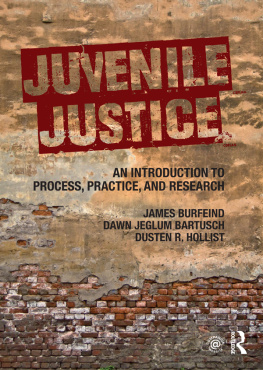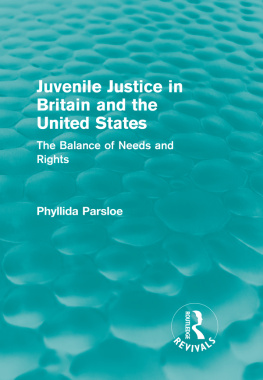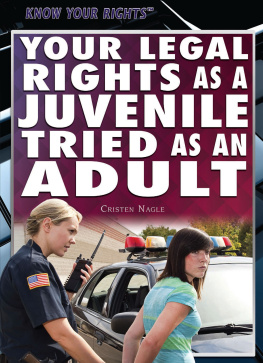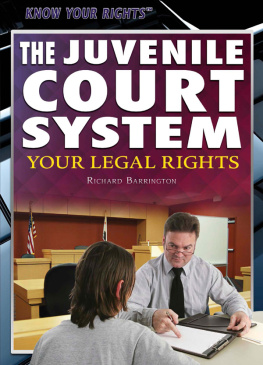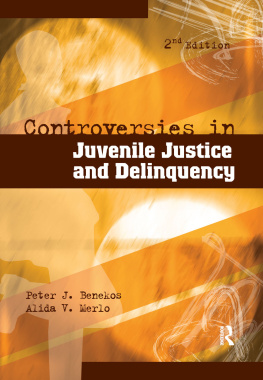Juvenile Justice
This book provides a comprehensive and thought-provoking introduction to the juvenile justice system in the United States. It begins by tracing the historical origins of the legal concept of juvenile delinquency and the institutional responses that developed, and analyzes the problem of delinquency, including its patterns, correlates, and causes. With this essential foundation, the greater part of the book examines the full range of efforts to respond to delinquency through both informal and formal mechanisms of juvenile justice. Core coverage includes:
- The history and transformation of juvenile justice,
- The nature and causes of delinquency,
- Policing juveniles,
- Juvenile court processes,
- Juvenile probation and community-based corrections,
- Residential placement and aftercare programs,
- Delinquency prevention,
- Linking systems of care.
This book is designed as a core text for courses on juvenile justice. Each chapter begins with a compelling case study and learning objectives that draw attention to the topics discussed. Each chapter ends with one or two readings that introduce readers to the literature on juvenile justice. In addition, critical thinking questions invite analysis of the material covered in the chapter.
A companion website offers an array of resources for students and instructors. For students, this includes chapter overviews, flashcards of key terms, and useful website links. The instructor site is password protected and offers a complete set of PowerPoint slides and an extensive test bank for each chapterall prepared by the authors.
James Burfeind is Professor of Sociology at the University of Montana.
Dawn Jeglum Bartusch is Associate Professor of Sociology and Criminology at Valparaiso University.
Dusten R. Hollist is Professor of Sociology at the University of Montana.
First published 2019
by Routledge
2 Park Square, Milton Park, Abingdon, Oxon OX14 4RN
and by Routledge
711 Third Avenue, New York, NY 10017
Routledge is an imprint of the Taylor & Francis Group, an informa business
2019 James Burfeind, Dawn Jeglum Bartusch and Dusten R. Hollist
The right of James Burfeind, Dawn Jeglum Bartusch and Dusten R. Hollist to be identified as authors of this work has been asserted by them in accordance with sections 77 and 78 of the Copyright, Designs and Patents Act 1988.
All rights reserved. No part of this book may be reprinted or reproduced or utilized in any form or by any electronic, mechanical, or other means, now known or hereafter invented, including photocopying and recording, or in any information storage or retrieval system, without permission in writing from the publishers.
Trademark notice: Product or corporate names may be trademarks or registered trademarks, and are used only for identification and explanation without intent to infringe.
British Library Cataloguing-in-Publication Data
A catalogue record for this book is available from the British Library
Library of Congress Cataloging-in-Publication Data
Names: Burfeind, James W., 1953 author. | Bartusch, Dawn Jeglum,
author. | Hollist, Dusten, author.
Title: Juvenile justice : an introduction to process, practice, and research /
James Burfeind, Dawn Jeglum Bartusch and Dusten Hollist.
Description: Abingdon, Oxon ; New York, NY : Routledge, 2018. | Includes
bibliographical references and index.
Identifiers: LCCN 2018003048| ISBN 9781138843219 (hardback) |
ISBN 9781138843226 (pbk.) | ISBN 9781315731087 (ebook)
Subjects: LCSH: Juvenile justice, Administration ofUnited States. |
Juvenile delinquencyUnited States. | Juvenile correctionsUnited States.
Classification: LCC HV9104 .B8524 2018 | DDC 364.360973dc23
LC record available at https://lccn.loc.gov/2018003048
ISBN: 978-1-138-84321-9 (hbk)
ISBN: 978-1-138-84322-6 (pbk)
ISBN: 978-1-315-73108-7 (ebk)
Typeset in Minion Pro
by Florence Production Ltd, Stoodleigh, Devon, UK
Visit the companion website: routledge.com/cw/burfeind
To the men and women, children and youth who comprise the juvenile justice system.
J.B., D.J.B., D.R.H.
To my wonderful wife, Linda, who puts up with my never-ending work on book projects, and does so with patience, support, and love.
J.B.
To my family, Mark, Joshua, and Claire, with gratitude for their encouragement and support while I worked on this new project.
D.J.B.
To Cheri, Mariah and Tristen, for your support and inspiration.
D.R.H.
Contents in Brief
PART I
Introduction to juvenile justice
PART II
Understanding the problem of delinquency
PART III
Juvenile justice process
PART IV
Partnerships in juvenile justice
Contents
PART I
Introduction to juvenile justice
1 The study of juvenile justice
A separate system of justice for juveniles
Juvenile justice reform
Juvenile justice process, practice, and research
Exploring the literature on juvenile justice: Chapter readings
Summary and conclusions
2 Origins and transformation of juvenile justice
The social construction of juvenile delinquency
The discovery of childhood and adolescence
The parens patriae doctrine
Positivist criminology
Inventing juvenile justice: Institutional responses to juvenile delinquency
Poor laws, charities, and pauperism
Houses of refuge and moral reform
Placing-out and orphan trains
Reform schools
The child-saving movement
Creation of the juvenile court (1899)
Reforming juvenile justice: Transformation of juvenile justice philosophy, policy, and practice
Challenges to the traditional juvenile court
The due process revolution in juvenile justice
The Juvenile Justice and Delinquency Prevention Act of 1974
Getting tough: Initiatives for punishment and accountability
Contemporary juvenile justice reform: Return to rehabilitation
Summary and conclusions
Readings
2.1 The Illinois Juvenile Court Act of 1899 National Council of Juvenile and Family Court Judges (1998)
2.2 Report BriefReforming Juvenile Justice: A Developmental Approach National Research Council (2012)
3 Juvenile justice law, structure, and process
Juvenile delinquency and juvenile justice in statutory law
Structure of juvenile justice systems: Decentralized and fragmented
Juvenile justice process: Discretion, diversion, major decision points, and disproportionate minority contact
Discretion and diversion
Major decision points
Disproportionate minority contact
Summary and conclusions
Readings
3.1 Excerpts from Juvenile Offenders and Victims: 2014 National Report Sickmund and Puzzanchera (2014)
3.2 The Cumulative Effect of Race and Ethnicity in Juvenile Court Outcomes and Why Preadjudication Detention Matters Rodriguez (2010)
PART II
Understanding the problem of delinquency
4 Data on delinquency and juvenile justice
Official data
Uniform Crime Reporting program
Redesign of the UCR program
Strengths of UCR data
Weaknesses of UCR data
Juvenile Court Statistics

